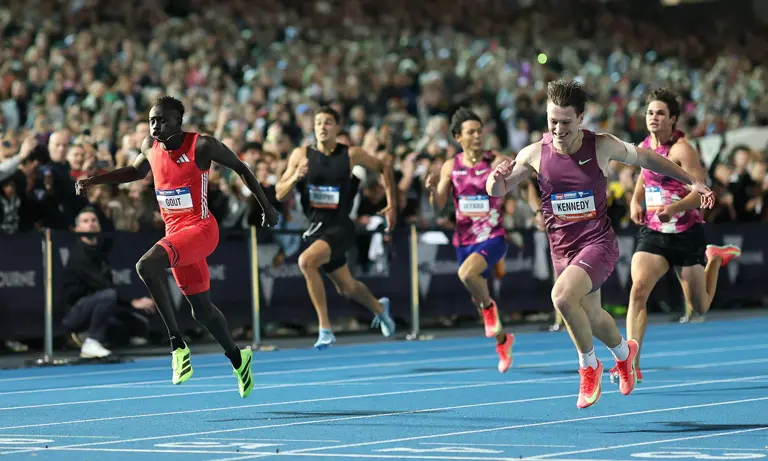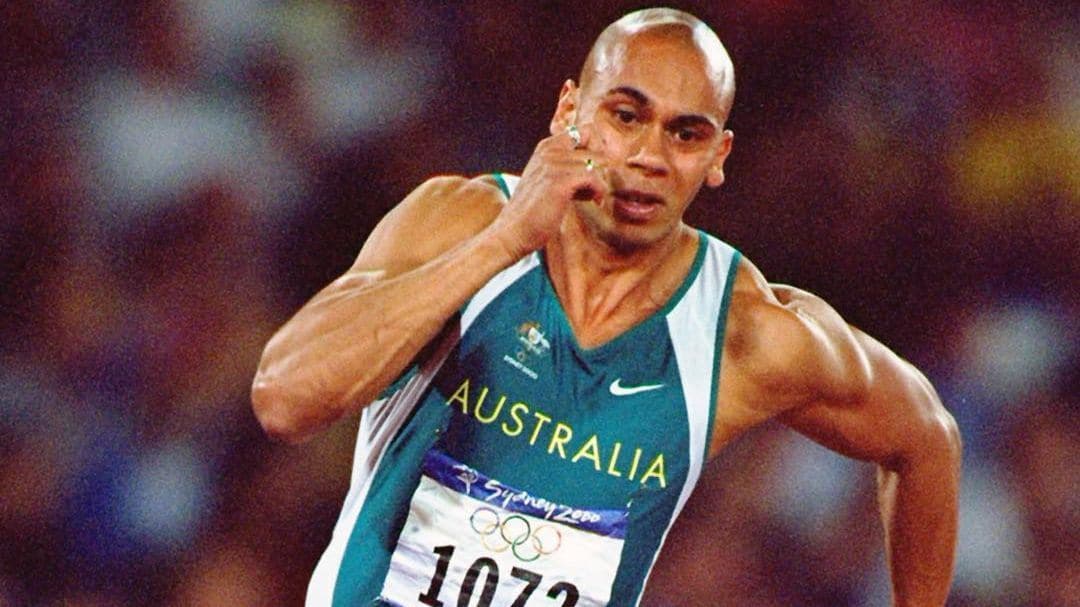A column by Len Johnson
Many years of following football teams – Queens Park Rangers, Melbourne Victory, Australia – has taught me one thing: always check the offside flag.
Whether you’re leaping out of your seat with both arms thrown aloft, or slumping down with both arms wrapped around your head trying to ‘unsee’ what just happened, hold your elation or despair in check a moment until you check if the referee’s assistant has the flag up for offside. Of course, then you’ll have to hold it in check even longer if, as the commentators rather puzzlingly put it, “VAR gets involved.”
Sprinting’s own version of the ‘check the offside flag’ rule is the wind gauge. Maximum allowable wind assistance in the 100 and 200 metres and the sprint hurdles is two metres per second. Anything more and the performance doesn’t count for record and/or qualifying purposes. ‘Offside,’ in other words.
In two otherwise incandescent performances within as many hours in the U20 100 metres at the Australian championships in Perth, Gout Gout was flagged offside. Gout (aka ‘sprint sensation’) recorded 9.99 seconds in both heat and final, but he cannot claim a record-eligible sub-10 because the wind gauge readings were 3.5 metres per second (heat) and 2.6 (final). Wind gauges formerly operated by an official are now usually integrated into the timing system and the reading displayed electronically. It was futile to argue with a human, but it’s impossible to argue with a machine.

Oh, the injustice of it all. Up in the commentary box, Bruce McAvaney and Dave Culbert agreed it was a very unfortunate turn of events but from that point their responses diverged. McAvaney insisted we had still seen something special: we certainly had. Big Dave wanted to go out, find a professor of meteorology, and implore them to ‘say it ain’t so’ (much as I sympathise, I’m going with Bruce on this one. To watch Gout run is uplifting, outcome regardless).
An electronic gauge having twice confounded Gout perhaps we should not have been surprised that he would be upstaged a third time within not much more than 12 hours when Matt Denny produced his second national record in four days at a throws meeting in Oklahoma. Not just a national record either; having thrown 72.07 four days previously, this time Denny produced a 74.25 throw, second-longest ever and just 10 centimetres short of the world record Mykolas Alekna established at the same venue last year.
There’s an irony here. Over in Perth, Gout is denied by the wind while half a world away Olympic bronze medallist Denny, exempted (justifiably, we must add) from the very same championships at which Gout is competing, throws the second-longest distance ever in an Oklahoma field chosen precisely because it offers perfect wind assistance to throwers. No offside trap in the discus!
Whichever way you cut it though, Denny has moved to no.2 all-time while Gout – and the open sprinters including Lachie Kennedy who will follow on day two – are aiming for sub-10, a mark that has been breached by no fewer than 200 men since Jim Hines first did it at the Mexico City 1968 Olympics (Patrick Johnson’s national record 9.93 sits at around the 100 mark).
One further point on Matt Denny, while he may have missed the world record by 10 centimetres he did out-perform Mykolas Alekna for consistency. Digging deeper into the stats, Alekna’s series averaged at 71.80 metres. All six throws were legal. Denny’s series – 71.03, 73.46, 74.25, 72.93, 71.14 and 73.56 – averaged almost a full metre further at 72.72. Arguably the best series ever.

Now, back to Perth which again lived up to its reputation as a Mecca for sprinters, albeit with sometimes excessive winds. What the wind gives with consistency, it sometimes takes with being record-illegal.
It was Gout’s misfortune to cop excessive wind assistance twice while the women’s U20 heats and final immediately before his races were comfortably with the maximum legal wind reading as were the other 100s contested on day one of the senior and U20 champs. That’s true enough, but if you look at the horizontal jump wind readings running through the day, most with the advantage of the same winds, there are plenty of jumps there with over 2mps tails.
For what it’s worth, my experience of Perth conditions – the 2010 nationals and several visits for earlier versions of the Perth Track Classic, largely when Linford Christie was part of the action – has been that it is not only the quantity of the wind as expressed in the reading, but also the quality. The wind blows at the same velocity all the way along the straight. Unlike other venues, the wind read at the gauge half-way along the 100 metres will be very little different from start to finish.
This strikes you when you look at the men’s all-time list under all conditions. Patrick Johnson has the fastest times ever in Perth with his 9.88 (wind +3.6) in 2003. He also ran 9.90 (+5.7) that day. WA sprinter Rod Mapstone, a member of the 4×100 relay team at the 1996 Olympics and 1997 world champs, ran a hand-timed 9.7 (+6.6) in 1996. This converts to 9.94 using the standard hand to electronic times formula. Across the other side of the country, Rohan Browning ran 9.96 (+3.3) in Wollongong in 2021 and now Gout has twice run 9.99 (+3.5 and +2.6), again in Perth.

Gout turned 17 in the last few days of December last year and is by some way the youngest of the fastest Australian men in history. One other young man on the all-time, all conditions list is Paul Narracott, a Queenslander who sprang to attention with a hand-timed 10.0 seconds (+1.3) to win the national title in 1978 a few months past his nineteenth birthday. Hines’ 9.95 was still the world record then and remained unbroken until 1983.
Narracott twice ran 9.9 in the next few years and boasted a win over Carl Lewis in an indoor 60 metres in 1984. Of greater relevance here, he made the 100 final at the first world championships in Helsinki in 1983, the only male sprinter to reach a world or Olympic 100 final since Hec Hogan won a bronze medal in Melbourne in 1956.
Can anyone emulate Paul Narracott in 2025.